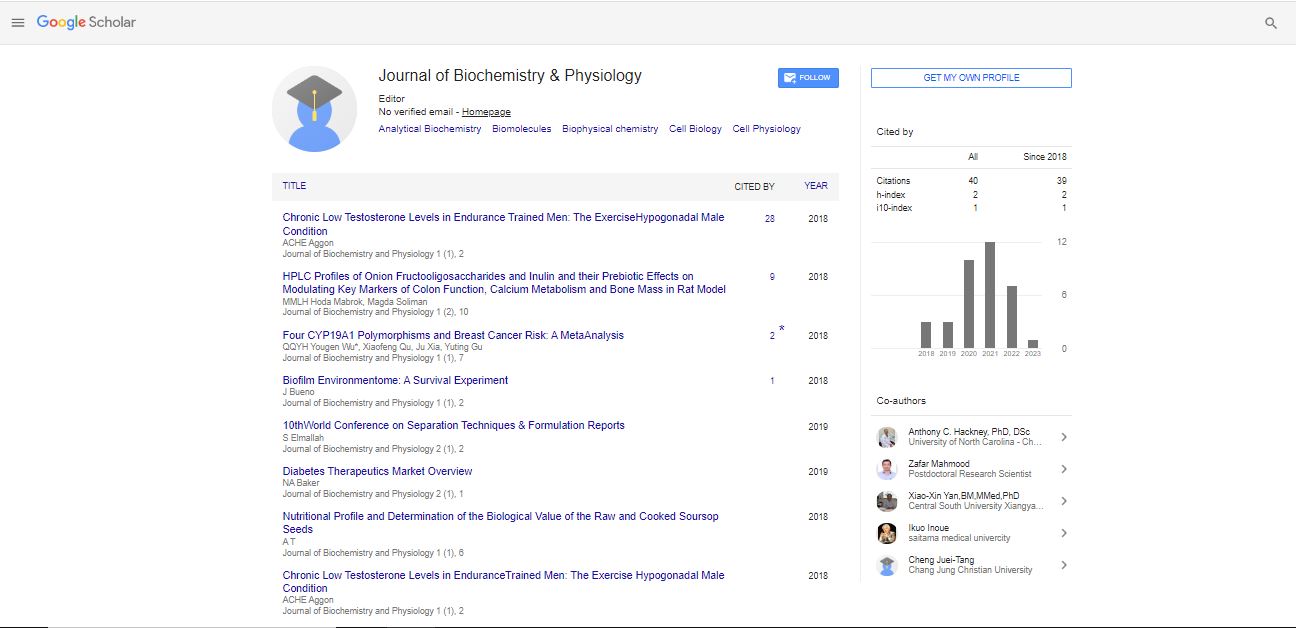Perspective, J Biochem Physiol Vol: 6 Issue: 1
Biogenesis of Cells: A Complex and Intricate Process
Felise Scari*
1Department of Molecular and Biomedical Science, University of Adelaide, Adelaide, Australia
*Corresponding Author: Felise Scari
Department of Molecular and Biomedical
Science, University of Adelaide, Adelaide, Australia
E-mail: felisescari@gmail.com
Received date: 20-Feb-2023, Manuscript No. JBPY-23-93412;
Editor assigned date: 22-Feb-2023, PreQC No. JBPY-23-93412 (PQ);
Reviewed date: 09-Mar-2023, QC No JBPY-23-93412;
Revised date: 16-Mar-2023, Manuscript No. JBPY-23-93412 (R);
Published date: 23-Mar-2023, DOI: 10.4172/jbpy.1000122
Citation: Scari F (2023) Biogenesis of Cells: A Complex and Intricate Process. J Biochem Physiol 6:1.
Description
The cell biogenesis or the formation of new cells is a fundamental aspect of biology. It is the process by which new cells are produced from pre-existing cells, which is essential for the growth and development of organisms as well as for the maintenance of tissues and organs the biogenesis of cells, the various stages involved in the process, and the factors that influence it.
Stages of biogenesis
The biogenesis of cells is a complex and intricate process that involves several stages. The first stage is the replication of DNA, which occurs during the interphase of the cell cycle. During this stage, the DNA molecule unwinds, and the two strands separate, allowing the DNA polymerase enzyme to synthesize a new complementary strand of DNA. This results in two identical copies of the DNA molecule, which will be distributed to the two daughter cells during cell division.
The next stage is cell division, which can occur by two different mechanisms mitosis or meiosis. Mitosis is the process by which one cell divides into two identical daughter cells, each with the same number of chromosomes as the parent cell. Meiosis, on the other hand, is the process by which the number of chromosomes is reduced by half, resulting in the formation of four daughter cells, each with a unique combination of genetic material.
After cell division, the newly formed cells enter the G1 phase of the cell cycle, where they grow and mature. During this phase, the cell synthesizes new proteins and organelles, which are necessary for its proper functioning. The G1 phase is followed by the S phase, where DNA replication occurs again, and the cell prepares for another round of cell division.
Factors influencing biogenesis: Several factors influence the biogenesis of cells, including genetics, environmental cues, and cellular signaling pathways. The genetic makeup of a cell determines its fate and function, and mutations in genes that regulate cell division can lead to abnormal cell growth and the development of cancer.
Environmental cues, such as nutrients, growth factors, and mechanical forces, can also influence cell biogenesis. The presence of specific growth factors can stimulate cell division, while the absence of nutrients can inhibit it. Mechanical forces can also play a role in cell division, as cells need to be anchored to a substrate to divide properly.
Cellular signaling pathways, such as the Wnt pathway, the Notch pathway and the Hedgehog pathway are also important regulator of cell biogenesis. These pathways communicate signals between cells, leading to changes in gene expression and cell behavior. Dysregulation of these pathways can lead to developmental defects and disease.
Conclusion
In conclusion, the biogenesis of cells is a complex and intricate process that involves several stages and is influenced by various factors. The study of cell biogenesis is essential for understanding the growth and development of organisms, as well as for the development of new therapies for diseases such as cancer. Once inside the cell, these molecules are subjected to the action of enzymes, which are highly specialised, large, intricately folded molecules. By binding to ingested molecules and controlling the rate at which they are chemically altered, enzymes act as catalysts. These chemical modifications increase the utility of the molecules to the cell. Catalysts, unlike ingested molecules, are not chemically altered during the reaction, allowing a single catalyst to regulate a specific chemical reaction in many molecules.
